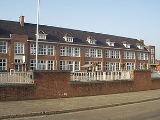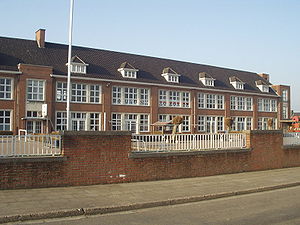
Aarsele
Encyclopedia
Aarsele is a village in the Belgium
Belgian province of West Flanders and a subdivision of the city of Tielt
.
In earlier times Aarsele was under the rule of the Kortrijk
who had holdings divided into several fiefdoms such as Donsegem and Hogenhove. Some fiefdoms also belonged to ecclesiastical orders including the abbeys of Lobbes
and of Baudelo and Saint-Baafs in Ghent.
The main fiefdom however was Gruuthuse, which had 12 achterlenen (lords who are subject to another landlord). The achterlenen did not have title, which resided with the wealthy Lewis de Bruges
, famous for hosting Edward IV of England at his Bruges home after the king was exiled in 1471. Lewis was also a well known bibliophile whose collection of illuminated manuscripts was given, but for a few exceptions, to Louis XII of France
.
 Jan of Bruges was the last male descendant from the Gruuthuse line. After his death at the end of the 16th century, the fiefdom passed to Jakob II of Luxembourg. And by the marriage of his daughter to Jan van Egmont, the fiefdom was later transferred to the house of Egmont.
Jan of Bruges was the last male descendant from the Gruuthuse line. After his death at the end of the 16th century, the fiefdom passed to Jakob II of Luxembourg. And by the marriage of his daughter to Jan van Egmont, the fiefdom was later transferred to the house of Egmont.
In 1568, the son of Jan van Egmont, Lamoral
, was decapitated on orders from Philip II of Spain
in Brussels. After his death successively two childless sons came into possession of Gruuthuse. In 1617, and for the next two generations, the fiefdom was held by the Richardot family. Finally, the marriage of Guillaume to Carla-Eugenia brought an end to the feudal system, or Ancien Régime.
As Aarsele was situated on the road between Ghent and Tielt it was not immune to plunder. Thus the municipality was devastated by the geuzen
, a confederacy of nobles and malcontents, in 1580. Later during the 17th century French armies laid waste to the town in 1646 and 1690. Between those infamous dates, in 1666 Aarsele was visited by the plague.
In 1829, King Willem
visited this municipality.
Nearby is Hooge Crater
, site of a former village destroyed during World War I and a memorial to fallen soldiers who died in the area.
Belgium
Belgium , officially the Kingdom of Belgium, is a federal state in Western Europe. It is a founding member of the European Union and hosts the EU's headquarters, and those of several other major international organisations such as NATO.Belgium is also a member of, or affiliated to, many...
Belgian province of West Flanders and a subdivision of the city of Tielt
Tielt
Tielt is a Belgian municipality in the province of West Flanders. The municipality comprises the city of Tielt proper and the towns of Aarsele, Kanegem, and Schuiferskapelle.-History:Some traces of Gallo-Roman occupation have been found in this area...
.
History
The earliest written reference to Aarsele dates from 1038 when it appears as Arcela, a Germanic word joining arda (= meadow) and sali (= chamber, house).In earlier times Aarsele was under the rule of the Kortrijk
Kortrijk
Kortrijk ; , ; ) is a Belgian city and municipality located in the Flemish province West Flanders...
who had holdings divided into several fiefdoms such as Donsegem and Hogenhove. Some fiefdoms also belonged to ecclesiastical orders including the abbeys of Lobbes
Lobbes Abbey
Lobbes Abbey was a Benedictine monastery in Lobbes in Hainaut, Belgium. The abbey played an important role in the religious, political and religious life of the Prince-Bishopric of Liège, especially around the year 1000.-Foundation:...
and of Baudelo and Saint-Baafs in Ghent.
The main fiefdom however was Gruuthuse, which had 12 achterlenen (lords who are subject to another landlord). The achterlenen did not have title, which resided with the wealthy Lewis de Bruges
Lewis de Bruges
Lewis de Bruges, lord of Gruuthuse, prince of Steenhuijs , also called Loys, Louis de/of Gruuthuse or Lodewijk van Gruuthuuse, was a Flemish, courtier, bibliophile, soldier and nobleman...
, famous for hosting Edward IV of England at his Bruges home after the king was exiled in 1471. Lewis was also a well known bibliophile whose collection of illuminated manuscripts was given, but for a few exceptions, to Louis XII of France
Louis XII of France
Louis proved to be a popular king. At the end of his reign the crown deficit was no greater than it had been when he succeeded Charles VIII in 1498, despite several expensive military campaigns in Italy. His fiscal reforms of 1504 and 1508 tightened and improved procedures for the collection of taxes...
.

In 1568, the son of Jan van Egmont, Lamoral
Lamoral, Count of Egmont
Lamoral, Count of Egmont, Prince of Gavere was a general and statesman in the Habsburg Netherlands just before the start of the Eighty Years' War, whose execution helped spark the national uprising that eventually led to the independence of the Netherlands.The Count of Egmont headed one of the...
, was decapitated on orders from Philip II of Spain
Philip II of Spain
Philip II was King of Spain, Portugal, Naples, Sicily, and, while married to Mary I, King of England and Ireland. He was lord of the Seventeen Provinces from 1556 until 1581, holding various titles for the individual territories such as duke or count....
in Brussels. After his death successively two childless sons came into possession of Gruuthuse. In 1617, and for the next two generations, the fiefdom was held by the Richardot family. Finally, the marriage of Guillaume to Carla-Eugenia brought an end to the feudal system, or Ancien Régime.
As Aarsele was situated on the road between Ghent and Tielt it was not immune to plunder. Thus the municipality was devastated by the geuzen
Geuzen
Geuzen was a name assumed by the confederacy of Calvinist Dutch nobles and other malcontents, who from 1566 opposed Spanish rule in the Netherlands. The most successful group of them operated at sea, and so were called Watergeuzen...
, a confederacy of nobles and malcontents, in 1580. Later during the 17th century French armies laid waste to the town in 1646 and 1690. Between those infamous dates, in 1666 Aarsele was visited by the plague.
In 1829, King Willem
William I of the Netherlands
William I Frederick, born Willem Frederik Prins van Oranje-Nassau , was a Prince of Orange and the first King of the Netherlands and Grand Duke of Luxembourg....
visited this municipality.
Attractions
The Delmerens Mill, also called Termote Mill, is a registered grain and oil mill dating from 1897, which ceased to operate in 1956. Saint Martins Church is a nationally registered structure, with an interesting interior, a pulpit dating from about 1200 and splendid glass windows. On the south side two bas relief sculptures are a memorial to the battle which was fought in Aarsele in May 1940. In 1909, the building was rebuilt in field stone in early Gothic style and rectangular steeple.Nearby is Hooge Crater
Hooge Crater Commonwealth War Graves Commission Cemetery
Hooge Crater Cemetery is a Commonwealth War Graves Commission burial ground for the dead of the First World War located in the Ypres Salient in Belgium on the Western Front....
, site of a former village destroyed during World War I and a memorial to fallen soldiers who died in the area.

